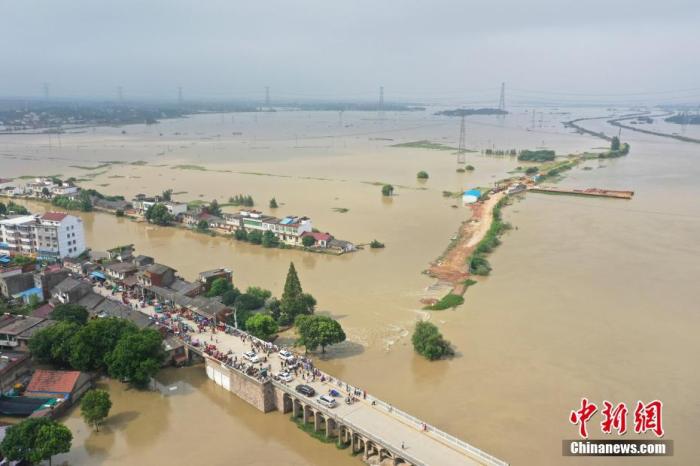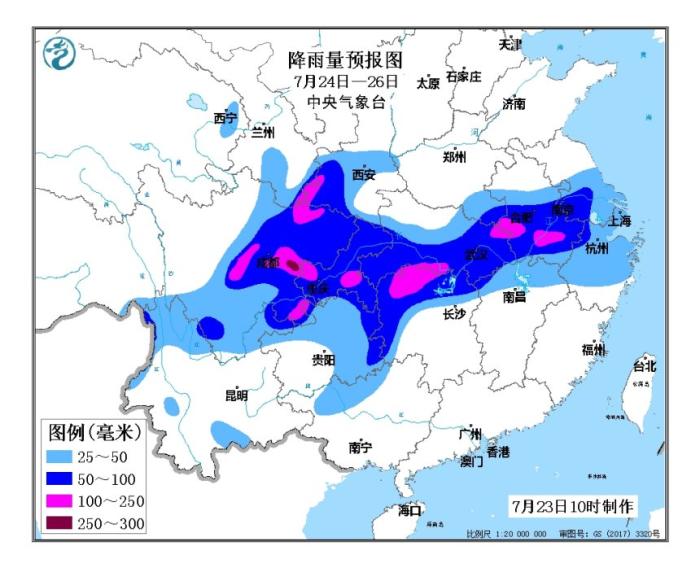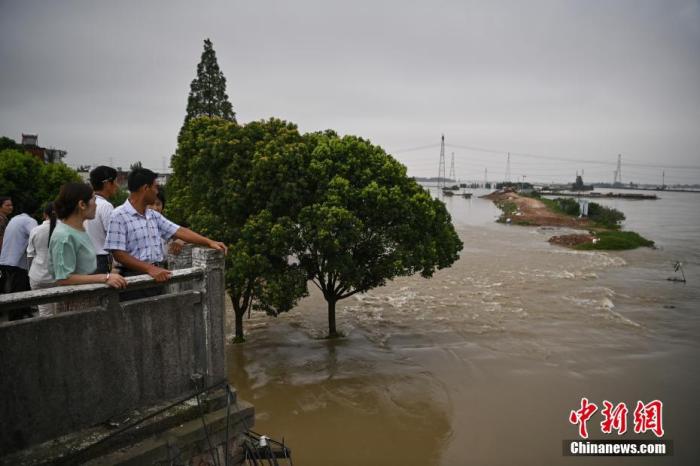Here we go again! From now on, the Yangtze River basin will welcome heavy rainfall again, and the high temperature in the south will continue to expand northward.
BEIJING, Beijing, July 24 (Xinhua) Just a few days after bidding farewell to the main rain belt, the Yangtze River basin has to face a strong attack of precipitation. According to the weather forecast, a new round of precipitation process has once again come online in the Yangtze River basin, which has added flood control pressure to the great rivers and lakes that are running at high water level. As the high temperature range continues to expand northward, high temperature weather will also appear in Jiangnan and North China.

On July 23, aerial photography was taken of the flooded villages around Baishan Bridge in Lujiang County, Anhui Province. On the 22nd, a breach occurred in Shidawei, Tongda Town, Lujiang County, Anhui Province, and floods flooded the nearby villages. China News Service reporter Zhang Yazi
A new round of precipitation returns to the Yangtze River basin, and the risk of mountain torrents is high.
The main rain belt affecting China is swaying from north to south, just rising to the north for two or three days, and returning to the Yangtze River basin in the next few days.
The Central Meteorological Observatory predicts that from July 24 to 26, there will be heavy rains along the Yangtze River from the Sichuan Basin, including heavy rains in parts of central Chongqing, northwestern Hunan, northeastern Hubei and southern Anhui (the cumulative rainfall is 100 ~ 200 mm, and the local area in the central Sichuan Basin can reach 250 ~ 300 mm); The maximum hourly rainfall in the above areas is 30 ~ 50 mm, and the local area exceeds 70 mm. There will also be strong convective weather such as thunderstorms and strong winds.

Rainfall Forecast Chart (July 24 -26)
Previously, the long rainy season has brought large-scale continuous heavy rainfall to the Yangtze River basin, with large accumulated rainfall, strong extremes and heavy disaster impact. According to the news of the National Climate Center on July 22, since June, the rainfall in the Yangtze River basin has been 486.8 mm, which is 54% more than the normal period, which is the highest in the historical period since 1961.
Meteorologists have warned that the main stream of the middle and lower reaches of the Yangtze River and Dongting Lake, Poyang Lake and Taihu Lake have maintained high water levels for a long time. This round of heavy rainfall from 24th to 26th may lead to further rise of the water level in the main branches of the Yangtze River and aggravate the flood disaster.
Gansu, Shaanxi, Sichuan, Chongqing, Hunan, Anhui and other places also need to guard against secondary disasters caused by heavy rainfall. China Meteorological Bureau, together with the Ministry of Natural Resources and the Ministry of Water Resources, issued the meteorological risk warning of geological disasters (yellow) and the meteorological warning of orange mountain torrents at 18: 00 on July 23rd.

On July 23, people observed the water situation on the Baishan Bridge in Lujiang, Anhui. On the 22nd, a breach occurred in Shidawei, Tongda Town, Lujiang County, Anhui Province, and the flood gradually flooded into the low-lying areas of nearby towns. China News Service reporter Cui Nan photo
The Yangtze River and Taihu Lake operate at high water levels, and the Chaohu Lake has a high water level once in a hundred years.
"At present, the water level in the main stream of the Yangtze River has exceeded the police for a long time, and the high water level in Taihu Lake fluctuates." On the 23rd, the Ministry of Water Resources held a consultation on the national flood, and the arrival of a new round of precipitation will undoubtedly bring challenges to the flood of great rivers and lakes.
At present, the flood situation in the Yangtze River basin is still grim. The continuous high water level in Jingjiang and Jiujiang sections of the main stream of the Yangtze River has reached more than half a month, and the No.2 flood is evolving.
Because the precipitation in the upper reaches of the Yangtze River will continue in the next few days, it is not conducive to the timely evacuation of flood control capacity of the upper reaches of the reservoir, and the flow of the main stream in the middle reaches of the Yangtze River has increased compared with the previous period.
Meteorologists believe that there are risks in the Yangtze River, such as high flood level, long maintenance time, affecting the wide reach of the river and the persistence of high flow in the later period. The risks in Jingjiang and Jiujiang are still high, especially the flood control pressure in Jingjiang continues to increase. At the same time, staged high temperatures, thunderstorms and strong winds will also adversely affect flood control and disaster relief.
From June 9 to July 21, the rainfall in Taihu Lake Basin was 583.8 mm, which was large, long-lasting and intense, and the total amount of plum rain had reached 2.42 times of the average for many years. Shanghai Central Meteorological Observatory (Taihu Lake Basin Meteorological Center) has started the first-level emergency response of meteorological support in Taihu Lake Basin.
Ma Leiming, director of the Taihu Lake Basin Meteorological Center and director of the Shanghai Central Meteorological Observatory, said that it is expected that there will be a precipitation process in the basin from the night of the 23rd to the morning of the 24th, and from the 26th to the 27th, and the rainfall in each area of the basin will reach 25-45mm in the coming week. The basin water control project will do its best to reduce the water level of Taihu Lake as soon as possible, relieve the pressure of flood control, and fully prepare for flood control in the subsequent precipitation process.
In addition, the water level in Chaohu Lake has exceeded the once-in-a-century standard for several days due to the continuous inflow of water from the upstream and the high water level in the downstream Yangtze River.
Cao Yuanyue, deputy commander of Chaohu City’s defense index, told the media on the 21st that the guaranteed water level of Chaohu City’s defense standard is 12 meters, and the water level of the lake has reached 13.41 meters, which means that Chaohu Lake has been in a "suspended lake" state. On the 22nd, due to the rising water level in Chaohu Lake, the dike in the even reach of Baishi Tianhe in Tongda Town, Lujiang County, Anhui Province collapsed, and the river overflowed the dike, forming a gap more than 20 meters wide, and the flood rushed into many villages.
In the coming week, there will be two rounds of heavy rainfall in Chaohu Lake. During this round of rainfall from 24th to 26th, the China Meteorological Bureau predicted that the area rainfall of Chaohu Lake was relatively large, with 30-50mm. According to the Chaohu municipal government, according to the current real-time water situation and work conditions, it is estimated that the water level of Zhongmiao will reach 13.6 meters around the 24th, which will bring great pressure on flood control.

Data Map: On July 13th, Fuzhou citizens traveled under the scorching sun. Photo by Zhang Bin
The high-temperature warning has been issued for 8 days, and the high temperature in the south of North China has "emerged"
At present, in the climate state that affects the whole country, another leading actor is undoubtedly the high temperature weather that is entrenched in South China and expanding northward. According to the China Weather Network, as of July 23rd, the Central Meteorological Observatory has issued a high temperature warning for eight consecutive days.
The Central Meteorological Observatory predicts that in the next three days, there will be high temperature above 35℃ in South China, Jiangnan, Beijing-Tianjin-Hebei and other places. Among them, the highest temperature in some areas of Fujian, south-central Jiangxi, southeastern Hunan and north-central Guangdong is 37 ~ 39℃, and the local temperature can reach 40℃. The Central Meteorological Observatory continued to issue a high-temperature yellow warning at 18: 00 on July 23.
In South China, which is controlled by subtropical high pressure, the air humidity is high, and the sultry feeling is very obvious. It is a veritable "small summer heat, steaming on the top and cooking on the bottom". Shi Yan, a meteorologist at China Weather Network, said that since mid-July, the hot weather in South China can be called "super-long standby". In Fujian and Guangdong, the highest temperature in 9 counties and cities (regions) exceeded the historical extreme value, and 13 counties and cities (regions) exceeded the historical extreme value in July.
With the continuous expansion of the high temperature range to the north, Jiangnan and North China have also joined the "high temperature group chat". For example, in Nanchang, the hot weather will last until the end of July, and the Beijing Meteorological Observatory also issued a blue warning of high temperature on July 23: It is estimated that the daily maximum temperature in most parts of Beijing will reach above 35℃ from July 24 to July 25.